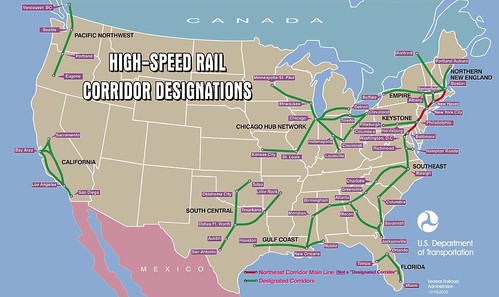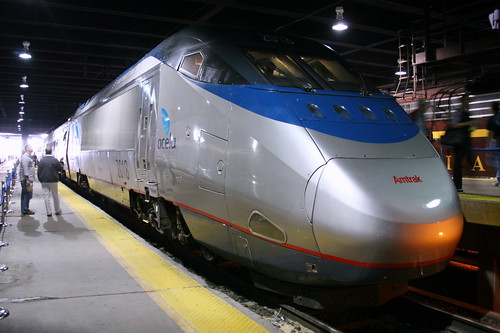NPR reviews South Africa’s High Speed Rail – $3B in costs; Cuts travel time between Joburg and Pretoria; and squeaky clean
via NPR
Heard this nice review of the “fastest train in whole of Africa” on NPR.

via NPR
Heard this nice review of the “fastest train in whole of Africa” on NPR.
Thanks to CNN for this awesome infograph.. Who knew – Japan, with a population of~127 Million people, clocked an amazing 8 Billion trips annually, which put it at the top among nations with most number of trips by train. Interestingly, next to Japan is India (with a population of 1.2 Billion), who despite its massive population only raked up 7.2 billion trips on its extensive rail network..
Hmmm.. Individual agendas and petty partisan politics are often the biggest road blocks for progressive nation building in most democracies around the world and the U.S. not so immune to this trend. An article from today’s New York Times documents such a situation and dissects the issues facing the High-Speed Rail program in light of the upcoming elections.
Republican candidates for governor in some of the states that won the biggest stimulus rail awards are reaching for the emergency brake.
In Wisconsin, which got more than $810 million in federal stimulus money to build a train linebetween Milwaukee and Madison, Scott Walker, the Milwaukee County executive and Republican candidate for governor, has made his opposition to the project central to his campaign.
Mr. Walker, who worries that the state could be required to spend $7 million to $10 million a year to operate the trains once the line is built, started a Web site, www.NoTrain.com, and has run a television advertisement in which he calls the rail project a boondoggle.
….Similar concerns are threatening to stall many of the nation’s biggest train projects. In Ohio, the Republican candidate for governor, John Kasich, is vowing to kill a $400 million federal stimulus project to link Cleveland, Columbus and Cincinnati by rail. In Florida, Rick Scott, the Republican candidate for governor, has questioned whether the state should invest in the planned rail line from Orlando to Tampa. The state got $1.25 billion in federal stimulus money for the project, but it will cost at least twice that much to complete.
And the nation’s most ambitious high-speed rail project, California’s $45 billion plan to link Los Angeles and San Francisco with trains that would go up to 220 miles per hour, could be delayed if Meg Whitman, a Republican, is elected governor. “In the face of the state’s current fiscal crisis, Meg doesn’t believe we can afford the costs associated with new high-speed rail at this time,” said Tucker Bounds, a campaign spokesman.
(Source: Green Inc, NY Times)

(Source: Wired)
(Source: Reuters)

Image: Seth Anderson via Apture
The Obama administration is expected to unveil its plans on Thursday for accelerating development of high-speed rail, a concept that in the past has had mixed political support and little public funding.
“It will be broad and strategic,” Karen Rae, acting head of the Federal Railroad Administration, told Reuters in an interview on Tuesday about the initiative described by officials as President Barack Obama‘s top transportation priority.
“It’s going to talk about how we begin to create this new vision for high-speed and intercity rail,” Rae said.
White House and transportation officials have spent the past several weeks weighing plans for developing at least six high-speed corridors.
High-speed rail initiatives are in various planning stages in California, Florida, Nevada, the Carolinas and the Northeast. States are already formulating how to use the large appropriation for high-speed rail projects in the economic stimulus act.
“Some of these plans are 20 years old,” said Transportation Secretary Ray LaHood in an interview this week with Reuters Financial Television.
In February, Congress included $8 billion for rail development in the American Recovery and Reinvestment Act and Obama has included another $5 billion for the efforts in the White House’s proposed budget.
LaHood said the $8 billion in stimulus money will “jump-start” the process, but rail advocates and transportation officials agree that financing high-speed rail nationally will cost significantly more.
The plan to be released on Thursday is required by the stimulus act, but Rae said it will “reference the broader rail agenda that is out there.”
Click here to read the entire article.
(Source: Bureau of Transportation Statistics (BTS) of the U.S. Department of Transportation)
This report is intended to provide timely, easily accessible information for the transportation community. It was developed by the Bureau of Transportation Statistics (BTS) of the U.S. Department of Transportation (DOT), and is updated on a regular basis on the BTS website.
The indicators fall under two broad categories: those that provide context about the economy and society in which transportation functions, and those that convey information about an aspect of transportation. To the extent possible, these latter indicators are transportation-wide in scope; however, some apply to only part of the transportation system. Reference tables at the beginning of the document provide key statistics about U.S. social and economic characteristics, and about the extent of the transportation system.
For indicators that are highly seasonal, the current value of that indicator is compared to the same time period in the previous year (e.g., April 2001 compared to April 2000). Otherwise, the tables show a comparison of the current value to a comparable preceeding period of time (e.g., the data for the month of April 2001 compared to that of March 2001).
(Source: Infrastructurist)
So, the absent minded editor of a certain infrastructure news site recently had an adventure in losing things on Amtrak trains. The experience was revealing and – spoiler alert – the much-slagged government owned and operated rail line acquitted themselves beautifully on matters of beyond-the-call-of-duty customer service.
For simplicity’s sake, let’s just call this editor “I.” Anyway, I was headed from Washington DC to New York on the 11 a.m. Acela. When the train reached Penn Station (on time), I gathered the various bags and coats I’d brought and exited the train. Not among the gathered possession was an iPhone, which was left unattended on the seat. I realized this as I was about to catch the subway home to Brooklyn, by which time the Acela had already scooted off for Boston.At this point the situation looked glum. It remained so through the course of the first conversation I had with an Amtrak employee. The gentleman, white haired and in his 50s, gave the classic bureaucrat’s shrug. “You gotta call lost and found in Boston,” he said. Shrug.
“Are they open today? Will they be open when the train arrives?” I asked. It was Sunday.
“They’re closed today,” he said. Shrug.
I gave him a pleading look. He shrugged again and turned away.
So even if some heroic individual wanted to return the device, it would take a return visit to the train station in Boston to actually be able to turn it in – assuming, say, she didn’t get off the train in Stamford or Providence or…
I went to the Customer Service office. There, a genial woman named Karen became my new best friend. She immediately began coordinating a multi-city search and rescue operation. Before I even finished explaining the situation, she was on the phone with an agent in New Haven to make arrangements for someone to dash onto the train and look for the device during the brief stopover there. She called the lost phone about a dozen times in hopes that someone would answer. At some point, a man did answer. His name was Mark and he was a conductor on the train. He promised that he would get the phone back to New York safely that evening. Karen’s liaison in New Haven organized a complicated hot handoff across the platform between Mark and a conductor southbound train. About four hours after I’d got off the train without, an Amtrak conductor walked up to me in Penn Station with a sealed envelope containing the lost phone. It was carefully bubble-wrapped.
(Source: Infrastructurist)
Everywhere you look, from Argentina to Saudi Arabia, there’s a country planning a new high-speed rail line. Contributor Yonah Freemark offered this incredible, easy to understand graphical depiction on Infrastructurist, which compares seven lines on four continents that are either in the engineering phase or already under construction. They range in size from the diminutive 34-mile project that will connect Jerusalem and Tel Aviv to the gargantuan 818-mile link between Beijing and Shanghai. The variations in construction cost per mile and local meaning of the term “high speed” are almost as great.
(Source: National Journal; Photo: Cliff @ Flickr)

Lisa Caruso @ the National Journal has kicked off an interesting dialogue on America’s proposed investment in Highspeed rail. She asks: “What do you think of President Obama’s decision to make high-speed passenger rail service a centerpiece of his transportation agenda? Is it a wise use of taxpayer dollars to spend $33 billion in the next five years (according to the stimulus and his FY10 budget outline) to make a down payment on constructing a rail network that could take decades to create? Or are there better ways to spend this money on transportation?
So far the following folks, including Virginia Governor Tim Kaine, Secretary of Transportation Ray Lahood, have recorded their opinions on this interesting dialogue. 7 responses: Steve Heminger, Phineas Baxandall, Greg Cohen, Gov. Tim Kaine, Peter Gertler, Ray LaHood, Bob Poole
So, continue to watch the thread as more folks step up to share their take on why HSR is very important for this nation.
Click here to read and follow the entire discussion.